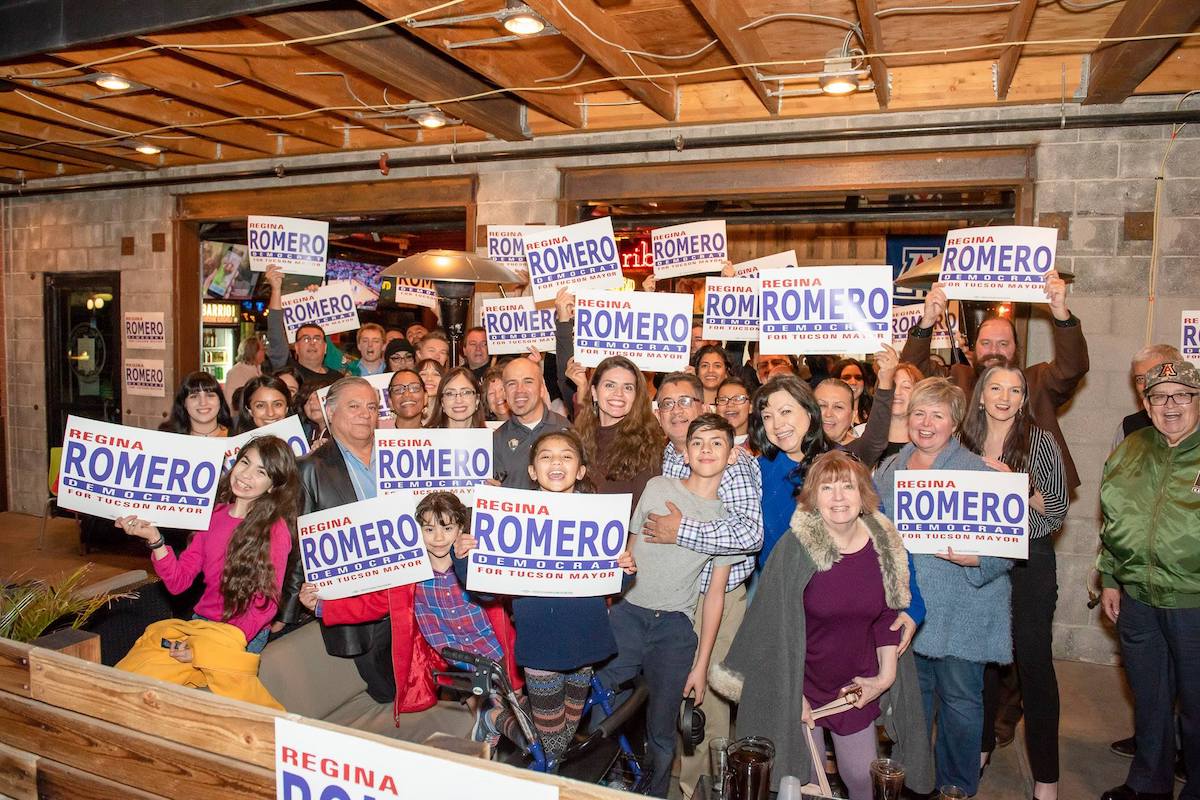

Photo via Regina Romero’s official Facebook page.
When Regina Romero, a 12-year veteran of the Tucson City Council, decided to run for mayor, she knew she would have to take a different approach than what the people of Tucson were used. If they were going to buy into her candidacy, this couldn’t be just about getting elected as mayor. This was about them, not her. This would be their campaign.
“We used traditional methods of getting elected,” Romero told Latino Rebels about her campaign strategy. Though it would not be easy, with only two campaign employees, and the rest all volunteers, they had their work cut out for them. “It was all grassroots. We hit thousands and thousands of doors, asking for votes at least three times,” she added.
Romero’s “people-powered movement” proved successful. In July, polling had shown only 15 percent of voters in support of Romero, with the majority going for former Arizona State Senator Steve Farley. Instead, in a major upset, Romero took the popular vote in the Democratic primaries. Then in the general election, Romero’s strategy proved itself once again by winning her 55.7 percent of the popular vote against Edward Ackerley, who ran as an Independent and received 39.7 percent.
But it wasn’t the numbers that made this win so historic.
Tucson, a city of approximately 500,000 people, is 42 percent Latino. Nobody of Latino descent has been mayor of the city since 1875. Romero’s election win is historic on many levels. The first Latina and the city’s first-ever woman mayor.
“It feels really incredible that we made history, but it’s bittersweet,” Romero said. “We have to ask ourselves—why did it take so long?”
Also on the ballot was the controversial Proposition 205, a measure that would declare the Tucson a “sanctuary city” for immigrants. The measure was met with overwhelming rejection by voters, some of which claimed the proposition “went too far.” This came as a surprise to many, considering that Tucson has a long history of helping migrants. The city played a major role in the 1980’s sanctuary movement, providing support to immigrants from Central and South American countries displaced by political turmoil.
“I don’t want people to confuse the measure losing with how Tucsonans feel about welcoming immigrants to the community,” Romero said about voters’ rejection of Prop 205, citing Tucson’s history in aiding migrants including the pushback against SB 1070, and opposition of Donald Trump’s “border wall.”
Determined to demonstrate her city’s welcoming nature, Romero laid out her plans to make sure that immigrants will still feel safe coming to Tucson.
(Her)story. #ThisIsTucson pic.twitter.com/27HTPl4kV0
— Regina Romero (@TucsonRomero) November 8, 2019
“We are the blue island in a red state,” she said, “I, as the new mayor, have vowed to continue working on making it easier for immigrants to live in our city in a safe way.” Romero then mentioned her desire to issue a municipal ID that would allow everyone to get a government ID necessary for the most basic necessities, like opening a checking account or getting an apartment.
A Voice of Change?
The new mayor also noted that a Romero administration will go beyond the ballot and beyond immigration.
“I want to raise the flags for the Native American nations that have been here for 4,500 years,” Romero told Latino Rebels. “The Tohono O’odham Nation has been in the Tucson basin for 4,500 years. They are the people of this land. The Pascua Yaqui pueblo has also had a long history in the Sonoran Desert that covers La Frontera.” Permission has already been asked of the tribal leaders and they have been invited to attend and participate when those flags are raised in the City Council chambers. “It’s just a simple thing I can do, but it is so meaningful to me to do that.”
Romero also intends to tackle climate change on a local level. “We’ve done well as a city in protecting our water, and little things here and there, but we have not put together a comprehensive and bold climate action plan.”
Amid the crisis of climate change, Tucson is the Southwest’s third-fastest heating city. Armed with this knowledge, Romero has vowed to make a difference for her city in whatever way she can.
“I know that climate change and climate action is a national and an international issue that we have to deal with, but there are ways of mitigating climate change here in Tucson,” she said.
Among the ways she plans to accomplish this, Romero listed electrifying public transportation, increasing the number of solar installations around the city, installing an electrical vehicle grid, and creating a climate change advisory board.
Romero also plans on working to improve the quality of life for the city’s most underprivileged communities, improving roads, supporting small businesses, and improving public education.
“That is a state issue, but I am the mom of two beautiful bilingual, bicultural children, and they go to public schools. I’m a product of public schools. Everyone deserves a good quality public education,” she said.
***
Joseph Paul Wright is a freelancer journalist based in Nogales, Arizona. He tweets from @joewrightwrites.



[…] pay a little closer attention to the Grand Canyon State in 2020. Party lines seem to be shifting, local elections and state offices are filling up with Democrats, and the margins between Republican wins and Democratic losses are […]